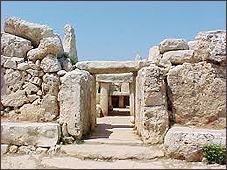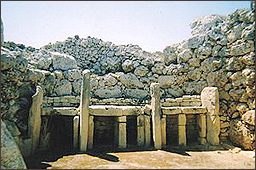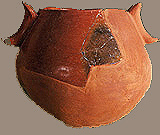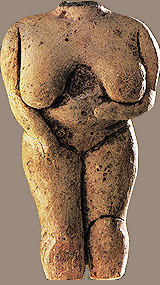 |
 |
PREHISTORIC ARCHAEOLOGY OF THE TEMPLES OF MALTA |
Page 1/6 |
The oldest buildings in Europe are found in Malta - older than the
Pyramids of Egypt. The occupation and settlement of Malta by modern humans began approximately 7,000 years ago, when the first
Neolithic Farmers crossed the 50 mile-wide straits that separate the islands from Sicily. Prior to that, the islands were uninhabited. The undomesticated animals, at the beginning of the Holocene [12-10,000 years ago] would have been red deer, bear, fox and wolf. Much earlier than that, there is archaeological evidence of Pleistocene species [c. 250,000 years ago] such as dwarf elephants and hippopotami.
Ggantija Phase of Temple Building
 |
THE CHRONOLOGICAL SEQUENCE OF MALTESE ARCHAEOLOGY |
The chronological sequence of Maltese archaeology is characterised by chapters, beginning with the earliest presence of modern humans:
| Neolithic |
5,000 to 4,100 BC |
| Temple Period |
4,100 to 2,500 BC |
| Bronze & Iron Age |
2,500 to 700 BC |
| Phoenicio-Punic |
700 BC to 218 BC – the Phoenicians named the main island Malat, meaning 'safe haven' |
| Roman |
218 BC to AD 535 |
 |
THE NEOLITHIC FARMERS
|

The impetus to cross over to Malta from the southern tip of Sicily, from where it was visible, was probably land pressure created by the expanding farming communities [Bonanno 1997].
Red Skorba pottery with a bright red coating
The three waves of farming settlers are characterised by their pottery; first, the Ghar Dalam [pottery with geometric patterning], secondly the Grey Skorba [a dull, undecorated ware of greyish colour] and then the Red Skorba [pottery with a bright red coating].
Commercial and cultural contacts with the mother island – Sicily - occurred throughout this period, as evinced by examples of flint, obsidian and female figurines.
The early settlers worshipped a ‘mother goddess’ whose type is known from early statuettes found scattered around the Mediterranean. Similar statues are found on Malta, several being of uniquely large size. We know from physical evidence that worship in the Malta temples included animal sacrifice. Beyond this, little is known about the rites and rituals that took place there. Although the temples are large in overall extent, the interior chambers do not have enough room to hold more than a few people at one time. Therefore public worship in large groups would not have been possible. It is likely that the priests and priestesses carried out rites inside the temples, and the public was not invited, [Daniel Cilia, 2004], perhaps similar to the 'restricted' experience of the Palaeolithic caves of Europe, such as
Chauvet.
 |
THE TEMPLE BUILDERS |
The temples of Malta have been described as a suitable candidate for the ‘ancient wonders of world’ [along with the
Pyramids of Egypt, the Colossus of Rhodes, the Hanging Gardens of Babylon, the Mauseoleum at Halicanassus, Pharos Lighthouse of Alexandria, the Statue of Zeus at Olympia and the Temple of Artemis at Ephesus].
Venus of Malta
from Hagar Qim
The Maltese temples are constructed of stone - coralline limestone - in a cloverleaf (trefoil) floor plan. Their typical architectural elements include the incomplete dome and the horizontal arch, or post-and-lintel trilithon. The curvatures of the temples perhaps reflect the circular plan of ordinary dwellings of the time, but are also reminiscent of underground burial chambers.
The basic temple plan consists of a variable number of hemispheric chambers, or apses, branching off from a narrow entrance path. The apses are incomplete domes, built of ingeniously corbelled stone, broad at the base and curving in towards the top. However, a full dome could not be constructed using this technique; after the walls had been built up, the apse was roofed in animal hides which were suspended from timber poles. Pole-and-hide construction was also used for the doors.
It has been suggested that the temples might have represented the head, arms and legs of a deity, since one of the commonest kinds of statue found in these temples is a 'fat' woman (
Venus of Malta from Hagar Qim), a symbol of fertility.
This period can be categorized into phases:

| Zebbug – c. 4100-3800 BC |
| A new wave of farming settlers from Sicily, with a new ceramic kit of pear-shaped jars. |
| Mgarr – c. 3800-3600 BC |
| A short transitional stage, pottery with curved lines. |
| Ggantija – c. 3600-3000 BC |
| The Temples begin to be constructed, simply at first, but then increasingly more sophisticated. For example, the internal plan of the temple became heavily stylized in structure, evolving from the trefoil to the symmetrical five-apsed plan. |
| Saflieni – c. 3300-3000 BC |
Hypogeum, a structure hewn out of rock, three storeys high.
It was used for worship and burial. |
| Tarxien – c. 3000-2500 BC |
| Tarxien – c. 3000-2500 BC – the height of the temple-building phase. Several temples were constructed – Hagar Qim, Mnajdra, Borg in-Nadur, Tas-Silg and Tarxien. Construction had become very sophisticated, such as the immense stone blocks and the intricate facades of Hagar Qim. |
 |
THE MALTA TEMPLE BUILDERS - CONCLUSION |
The first inhabitants of Malta left no writing behind them, only elaborate, sophisticated and unprecedented stone structures in the form of temples. These temples, requiring extensive resources, were clearly an integral and religious element of their culture.
The archaeological record shows unequivocally that the Temple builders disappeared from around 2500 B.C. Whether this was due to over-exploitation and eventual exhaustion of the natural resources - parallels appear here with
Easter Island - compounded by successive years of drought or a climate change, remains speculative. Was the population completely wiped out, or assimilated? A warlike Bronze Age people, similar to those of Greece, southern Italy, and Sicily, succeeded the Temple builders, bringing with them an entirely new culture which included disposing of their dead by cremation.
→
Bradshaw Foundation















